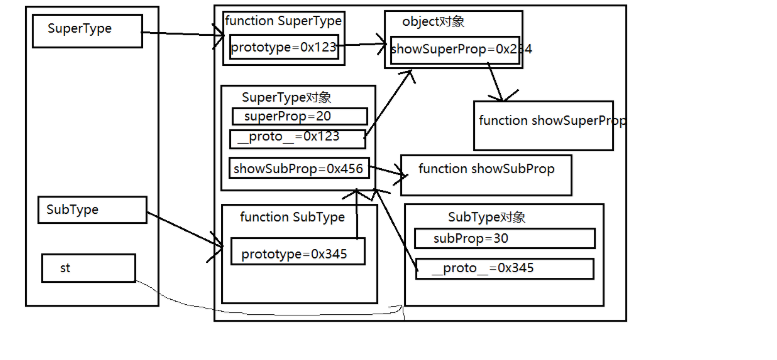一、原型链继承
方式1: 原型链继承
(1)流程:
1、定义父类型构造函数。
2、给父类型的原型添加方法。
3、定义子类型的构造函数。
4、创建父类型的对象赋值给子类型的原型。
5、将子类型原型的构造属性设置为子类型。
6、给子类型原型添加方法。
7、创建子类型的对象: 可以调用父类型的方法。
(2)关键:
- 子类型的原型为父类型的一个实例对象
// 1.定义父类型构造函数
function Supper() {
this.supProp = 'Supper property'
}
// 2.给父类型的原型添加方法
Supper.prototype.showSupperProp = function () {
console.log(this.supProp)
}
// 3.定义子类型的构造函数
function Sub() {
this.subProp = 'Sub property'
}
// 4.子类型的原型为父类型的一个实例对象
Sub.prototype = new Supper()
// 5.将子类型原型的构造属性constructor指向子类型
Sub.prototype.constructor = Sub
// 6.给子类型原型添加方法
Sub.prototype.showSubProp = function () {
console.log(this.subProp)
}
// 7.创建子类型的对象,可以调用父类型的方法
var sub = new Sub()
sub.showSupperProp() // Supper property
sub.showSubProp() // Sub property
console.log(sub) // Sub

(3)缺点:
1、包含引用类型值的原型,由于实例共享属性,一个实例对原型属性的修改会在另一个实例中反映出来。
2、不能向超类型的构造函数中传递参数。
二、借用构造函数继承
方式2: 借用构造函数继承。
(1)流程:
1、定义父类型构造函数。
2、定义子类型构造函数。
3、在子类型构造函数中调用父类型构造。
// 1.定义父类型构造函数
function Person(name, age) {
this.name = name
this.age = age
}
// 2.定义子类型构造函数
function Student(name, age, price) {
// 3.在子类型构造函数中调用父类型构造
Person.call(this, name, age) // 相当于: this.Person(name, age)
/*this.name = name
this.age = age*/
this.price = price
}
var s = new Student('Tom', 20, 14000)
console.log(s.name, s.age, s.price) // Tom 20 14000
(2)关键:
- 在子类型构造函数中通过
call()调用父类型构造函数。
(3)缺点:
1、无法避免构造函数模式存在的问题——方法都在构造函数中定义,无法函数复用。
2、在父类型原型中定义的方法在子类型中是不可见的,只能继承父类型构造函数中定义的属性和方法。
三、组合继承
方式3: 原型链+借用构造函数的组合继承。
1、利用原型链实现对父类型对象的方法继承。
2、利用call()借用父类型构造函数初始化相同属性。
function Person(name, age) {
this.name = name
this.age = age
}
Person.prototype.setName = function (name) {
this.name = name
}
function Student(name, age, price) {
Person.call(this, name, age) // 为了得到属性
this.price = price
}
Student.prototype = new Person() // 为了能看到父类型的方法
Student.prototype.constructor = Student //修正constructor属性
Student.prototype.setPrice = function (price) {
this.price = price
}
var s = new Student('Tom', 24, 15000)
s.setName('Bob')
s.setPrice(16000)
console.log(s.name, s.age, s.price)
四、原型式继承
function createObj(o) {
function F(){}
F.prototype = o;
return new F();
}
就是 ES5 Object.create 的模拟实现,将传入的对象作为创建的对象的原型。
缺点:包含引用类型的属性值始终都会共享相应的值,这点跟原型链继承一样。
var person = {
name: 'kevin',
friends: ['daisy', 'kelly']
}
var person1 = createObj(person);
var person2 = createObj(person);
person1.name = 'person1';
console.log(person2.name); // kevin
person1.firends.push('taylor');
console.log(person2.friends); // ["daisy", "kelly", "taylor"]
注意:修改person1.name的值,person2.name的值并未发生改变,并不是因为person1和person2有独立的 name 值,而是因为person1.name = 'person1',给person1添加了 name 值,并非修改了原型上的 name 值。
五、寄生式继承
创建一个仅用于封装继承过程的函数,该函数在内部以某种形式来做增强对象,最后返回对象。
function createObj (o) {
var clone = Object.create(o);
clone.sayName = function () {
console.log('hi');
}
return clone;
}
缺点:跟借用构造函数模式一样,每次创建对象都会创建一遍方法。
六、寄生组合式继承
在这里重复一下组合继承的代码:
function Parent (name) {
this.name = name;
this.colors = ['red', 'blue', 'green'];
}
Parent.prototype.getName = function () {
console.log(this.name)
}
function Child (name, age) {
Parent.call(this, name);
this.age = age;
}
Child.prototype = new Parent();
var child1 = new Child('kevin', '18');
console.log(child1)
组合继承最大的缺点是会调用两次父构造函数。
一次是设置子类型实例的原型的时候:
Child.prototype = new Parent();
一次在创建子类型实例的时候:
var child1 = new Child('kevin', '18');
回想下 new 的模拟实现,其实在这句中,我们会执行:
Parent.call(this, name);
在这里,我们又会调用了一次 Parent 构造函数。
所以,在这个例子中,如果我们打印 child1 对象,我们会发现 Child.prototype 和 child1 都有一个属性为colors,属性值为['red', 'blue', 'green']。
那么我们该如何精益求精,避免这一次重复调用呢?
如果我们不使用 Child.prototype = new Parent() ,而是间接的让 Child.prototype 访问到 Parent.prototype 呢?
看看如何实现:
function Parent (name) {
this.name = name;
this.colors = ['red', 'blue', 'green'];
}
Parent.prototype.getName = function () {
console.log(this.name)
}
function Child (name, age) {
Parent.call(this, name);
this.age = age;
}
// 关键的三步
var F = function () {};
F.prototype = Parent.prototype;
Child.prototype = new F();
var child1 = new Child('kevin', '18');
console.log(child1);
最后我们封装一下这个继承方法:
function object(o) {
function F() {}
F.prototype = o;
return new F();
}
function prototype(child, parent) {
var prototype = object(parent.prototype);
prototype.constructor = child;
child.prototype = prototype;
}
// 当我们使用的时候:
prototype(Child, Parent);
引用《JavaScript高级程序设计》中对寄生组合式继承的夸赞就是:
这种方式的高效率体现它只调用了一次 Parent 构造函数,并且因此避免了在 Parent.prototype 上面创建不必要的、多余的属性。与此同时,原型链还能保持不变;因此,还能够正常使用 instanceof 和 isPrototypeOf。开发人员普遍认为寄生组合式继承是引用类型最理想的继承范式。